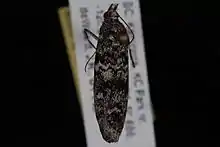Dioryctria abietivorella
Dioryctria abietivorella, the fir coneworm, is a species of snout moth in the genus Dioryctria. It was described by Augustus Radcliffe Grote in 1878,[1] and is found in North America from southern Canada south to California in the west and North Carolina in the east.
| Dioryctria abietivorella | |
|---|---|
 | |
| Scientific classification | |
| Kingdom: | Animalia |
| Phylum: | Arthropoda |
| Class: | Insecta |
| Order: | Lepidoptera |
| Family: | Pyralidae |
| Genus: | Dioryctria |
| Species: | D. abietivorella |
| Binomial name | |
| Dioryctria abietivorella (Grote, 1878) | |
| Synonyms | |
| |
The wingspan is 10–13 mm. The forewings are primarily black and white with a prominent spot.
The larvae feed on a wide range of coniferous hosts, but fir, spruce and Douglas-fir are the preferred hosts. They feed internally on cones, needles, twigs and under the bark of their host plant.[2]
References
- "GlobIZ search". Global Information System on Pyraloidea. Retrieved July 3, 2017.
- "Species Details: Dioryctria abietivorella". University of Alberta Museums. E.H. Strickland Entomological Museum. Retrieved December 28, 2020.
This article is issued from Wikipedia. The text is licensed under Creative Commons - Attribution - Sharealike. Additional terms may apply for the media files.